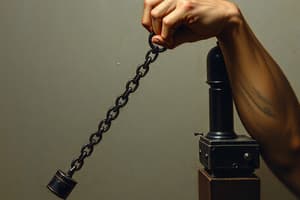Podcast
Questions and Answers
Which of these options describes the three parts of a lever?
Which of these options describes the three parts of a lever?
- Fulcrum, Force Point, Resistance Point (correct)
- Lever Arm, Weight, Fulcrum
- Effort Point, Load Point, Fulcrum
- Axis, Load, Effort
What is a first class lever?
What is a first class lever?
In the first class lever, the axis point is in the middle and the resistance and force points are on the edges.
What characterizes a second class lever?
What characterizes a second class lever?
The resistance point is in the middle, with the force and axis points on the edges.
What defines a third class lever?
What defines a third class lever?
The principle of levers states that Force x Force arm = __ x __.
The principle of levers states that Force x Force arm = __ x __.
Mechanical advantage (MA) is defined as MA = __ / __.
Mechanical advantage (MA) is defined as MA = __ / __.
When does a lever favor force over speed?
When does a lever favor force over speed?
When does a lever favor speed over force?
When does a lever favor speed over force?
What is the procedure for Jackson Strength Evaluation System?
What is the procedure for Jackson Strength Evaluation System?
To which lever classes do a golf club, a swinging door, and a shovel belong?
To which lever classes do a golf club, a swinging door, and a shovel belong?
How much force must be produced by the biceps brachii to support a weight of 95 newtons?
How much force must be produced by the biceps brachii to support a weight of 95 newtons?
The mechanical advantage of a first class lever is always less than one.
The mechanical advantage of a first class lever is always less than one.
Flashcards are hidden until you start studying
Study Notes
Three Parts of a Lever
- Force point (F): where effort is applied; the muscle's insertion point.
- Resistance point (R): where resistance acts; perpendicular from the fulcrum.
- Fulcrum (A): the axis of motion; center of gravity in the body segment.
First Class Lever
- Axis point is in the middle, with force and resistance points at the edges.
- Example: Triceps muscle at the elbow, similar to a see-saw.
Second Class Lever
- Resistance point is in the middle; force and axis points are at the edges.
- Example: A wheelbarrow.
Third Class Lever
- Force is positioned in the middle; resistance and axis points are at the edges.
- Example: Bicep muscle functioning as a shovel.
Principle of Levers
- Fundamental equation: Force × Force arm = Resistance × Resistance arm.
- Torque is calculated as: force × force arm / resistance × resistance.
Mechanical Advantages of Levers
- Mechanical Advantage (MA) formula: MA = FA / RA.
- Indicates how efficiently a lever amplifies force.
Force Lever
- A mechanical advantage that favors force when the force arm is longer than the resistance arm.
- First class levers may be force levers; second class levers always are.
Speed Lever
- A mechanical advantage that favors speed when the resistance arm is longer than the force arm.
- First class levers can also be speed levers; third class levers always are.
Jackson Strength Evaluation System Procedure
- Involves strapping equipment on hand or wrist, using the equipment applied in muscle strength testing.
Classification of Levers in Tools
- Golf club: Third class lever; top hand is the axis, bottom hand applies force, bottom of the club is the resistance.
- Swinging door: Second class lever; hinges act as the axis, door is the resistance, handle provides force.
- Shovel: Functions as a third class lever, similar to a golf club.
Calculation of Force by Biceps Brachii
- Assessment of force needed to support a 95 N weight in hand when attached at a 90-degree angle 4.0 cm from elbow's center of rotation, considering forearm and hand weight of 35 N at 17 cm from elbow.
Mechanical Advantage of First Class Lever
- The mechanical advantage (MA) varies based on arm lengths.
- MA > 1 when force arm is longer than resistance arm; MA < 1 when vice versa; MA = 1 when both arms are equal.
Studying That Suits You
Use AI to generate personalized quizzes and flashcards to suit your learning preferences.




